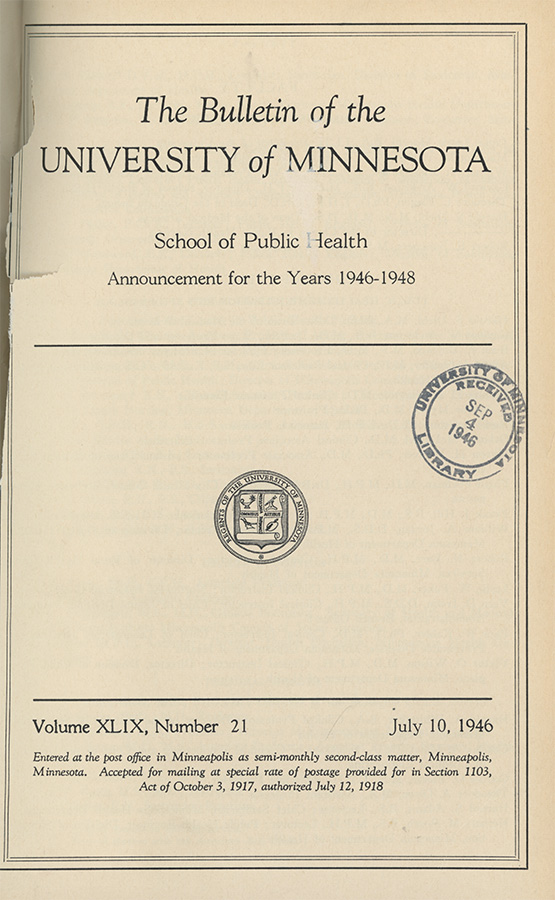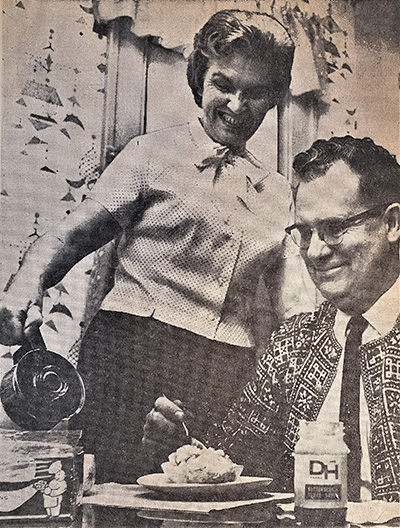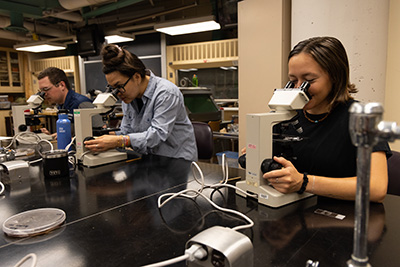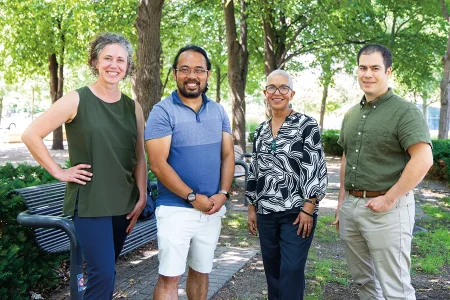
In July 1944, the University of Minnesota transformed the Medical School’s Department of Preventive Medicine and Public Health into the School of Public Health (SPH), and for the next 80 years the school’s curriculum has evolved to keep up with the most pressing public health challenges, preparing future professionals to meet those challenges with the latest research and education.
Responding to Post-war Needs
In the post-war years, the school focused on building up the public health workforce. The school’s first course bulletin offered classes leading to degrees for health officers, public health engineers, and public health educators.
During this time, the W.K. Kellogg Foundation felt that hospitals in the U.S. needed improvement and professional management. In 1946, the foundation funded a hospital administration program at SPH, and just two years later, that program granted its first Master of Healthcare Administration (MHA) degree. The mid-century baby boom emphasized the need for more maternal and child health support, which led SPH to establish the first maternal and child health MPH program in the U.S. in 1954. Today, these programs continue to thrive, training students in how to support all communities to ensure access to a healthy life.
Digital Revolution
As times changed, the school’s curriculum adapted as quickly as the world around it. Today, the curriculum reflects those changes in hybrid classes, online learning environments, courses
in data visualization, and a growing emphasis on harnessing the power of big data. Biostatistics, the study of data to inform health, began as the “biometry” program in 1953. By the 1960s, the program had trained more graduates than any other public health school in the country. The division is now called Biostatistics & Health Data Science — emphasizing the importance of data in statistical analysis and modeling — and continues to train dozens of students a year.
Equitable Access
In the last two decades, societal issues such as ethics, equity, racism, and climate change have played an ever-larger role in the curriculum, as our understanding of the biggest emerging threats to public health deepened. In response, the school’s curriculum recognizes how structural racism and implicit bias are dangerous threats to public health. SPH launched the first health equity minor in the nation for graduate students in 2017, followed by graduate minors in American Indian health and wellness; a graduate minor in sexual health; and a graduate minor in climate change and health, a growing health equity challenge.
Coming Full Circle
Health equity, social justice, and antiracism aren’t terms that appear in the first School of Public Health curriculum. Today, faculty and staff across the school are working to ensure that these issues are fundamental to everything the school does, including building up the public health workforce — the primary goal of the school in 1944 and even more critical today due to maldistribution of the public health workforce, particularly in underserved communities.
As the school celebrates 80 years of progress, it’s important to acknowledge that much work remains to fully realize health equity in public health. From responding to post-war needs to embracing the digital revolution, SPH is well-positioned to lead this effort. Continued commitment, innovation, and collaboration are essential as the school strives to address these enduring challenges and ensure a healthier future for all communities.
1946
SPH is one of the first nine schools of public health to be accredited by the American Public Health Association

1946
SPH establishes the first hospital administration program in the U.S.
1950
Epidemiology is formally recognized as a separate discipline within the school.
1953
SPH establishes a biostatistics program. By the 1960s, the SPH biostatistics program had trained more graduates than any other public health school in the country.

1954
The maternal and child health unit is established.

1958
SPH founds the first doctoral program in epidemiology in the U.S.
1964
SPH begins the public health nutrition program to train leaders in the field.

1986
Instructor Jim Rothenberger teaches one of the University’s first classes to address HIV infection.

2002
SPH, the College of Veterinary Medicine, and the College of Agriculture and Natural Resources collaborate to establish the Public Health Institute to provide professional development and applied, real-world learning experiences on cutting-edge public health topics.



